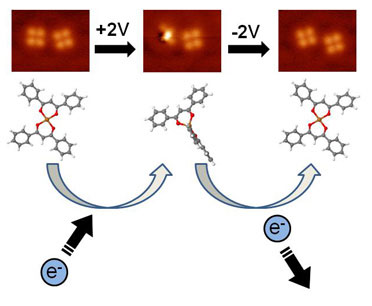| Jun 09, 2011 |
A molecule that switches on and off makes it usable as a bit of information
|
|
(Nanowerk News) A single molecule whose charge state and shape can be changed at will: the latest breakthrough at the CEMES (Centre d'Elaboration de Matériaux et d'Etudes Structurales, Center for Materials Elaboration and Structural Studies, CNRS) should prove a key advantage in the race for miniaturization. In addition to controlling its charge in a completely reversible way, the researchers have revealed a link between the molecule's charge and its geometrical shape, effectively making it usable as a bit of information or an electromechanical system on a nanometric scale. This perfectly controllable back-and-forth motion at the molecular level holds great promise for the creation of ultra-dense digital memory or nanomotors. The team's results are published in Physical Review Letters ("Controlling the Charge State of a Single Redox Molecular Switch").
|
 |
| Top: Images obtained by scanning tunneling microscopy illustrating the reversible switching sequence of a molecule on a thin insulating film. Bottom: Diagrams showing the molecule's geometry as a function of its charge state. On the left are two square, flat, electrically neutral molecules measuring about 1 nanometer. When the tip of the microscope is positioned over the molecule on the left, delivering a 2V current, the molecule is charged with an additional electron, inducing a conformational change to a pyramidal shape (center). This change is totally reversible: when a reverse current is applied, the molecule loses its charge and recovers its initial shape (right).
|
|
What the researchers at the CEMES (Centre d'Elaboration de Matériaux et d'Etudes Structurales, Center for Materials Elaboration and Structural Studies, CNRS) in Toulouse have developed is called a molecular switch: a molecule that can interchangeably adopt state A or state B under the influence of an external stimulus. In this specific experiment, the two states correspond to different molecular geometries: the composition remains the same but the shape changes. To induce the change, an electron must be added to the molecule, which constitutes the external stimulus. Adding an electron also introduces an additional repelling force, causing certain atoms to pull further away from each other and changing the molecule's shape from a flat, square configuration to a more voluminous pyramidal configuration.
|
|
From a technical point of view, the operation is made possible by the use of a scanning tunneling microscope (STM). The STM serves both as a camera to reveal the molecule's shape and as a tool for injecting electrons: when the microscope's tip applies an electrical tension, the molecule gains an electron and changes shape, becoming pyramidal. The process is completely reversible: when a reverse voltage is applied, the molecule releases the electron and recovers a flat shape and neutral charge. The CNRS researchers have measured the molecule's charge state in both configurations using an atomic force microscope (AFM), thus establishing the close link between the molecule's charge and its geometrical shape.
|
|
This switch opens the way to numerous applications, including the synthesis of elementary memory units on a molecular scale. The molecule's capacity to hold a charge and release it on demand could be used to encode binary information. In addition to applications in molecular electronics, it would be possible to use the molecule's geometrical transformation to produce a nanomachine. Controlling the charge transfer that determines the geometrical transformation could allow the creation of a stepper motor, for example.
|
|
This research was partially financed by the European Commission as part of the ARTIST project.
|

